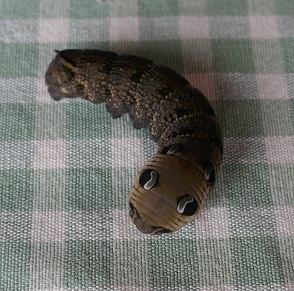
Enormous Larva.
Coming back from posting letters today in the Brackla letterbox, I discover this amazing creature attempting to cross the road in Piperhill. Never before have I seen such a huge caterpillar. It measures at least 8cm in length when stretched out in full stride. It moves at some speed too.
Elephant Hawk-moth.


You can see the larva feeding on one of its favourite plants, willowherb. Rosebay willowherb goes down well too, as does fuschia. In my photo, notice the mouth tucked away in a defensive pose. The larva tries to look scary. Whilst feeding, it is relaxed and stretched out. This larva can be seen between July-September then it burrows in soil around plant roots to emerge in spring in this wonderful pink outfit.

I just love stories like that. I have only come across this species once………..at my nursery school after the summer holidays. There was a pupating caterpillar, it was indeed huge, that was turning into a pupa outside, on the window sill of my office when we returned to open the school for the new session in August. The elephant hawk moth is indeed an impressive spectacle, as is the stage of the moth when it is pupating. I was fascinated never mind the children!
I’m sure that your nursery children will have grown up appreciating nature after a great start. You must have been a special teacher to share all these things, like butterflies inside the classroom. and moths on your window sill.
I have just found one crossing the pavement. I picked it up and placed it in my garden. What a fabulous creature it is. Beautiful as a youngster stunning as an adult
That’s great news, James. I know how thrilled you must have been to have found it. I think that giving it a home in your garden is the best thing that you can do for it. Thank you for sharing this with us. Best wishes, Ann.